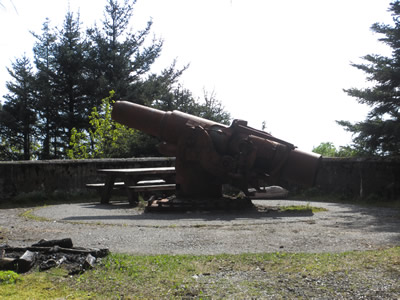Yakutat in Military History
 Follow the trails and explore Yakutat for hidden history and abandoned military fortifications. Search for naval gun batteries, landing vehicles and bunkers.
Follow the trails and explore Yakutat for hidden history and abandoned military fortifications. Search for naval gun batteries, landing vehicles and bunkers.
Yakutat played a vital role in Alaska military operations during WWII. The airport in use today was originally constructed in 1941 as a landing field for transport aircraft between Washington State and Elmendorf Air Force Base.
Yakutat Army Airfield, a large aviation garrison and paved runway, was constructed as part of the United States Army's long-range defense program for Alaska. Brigadier General Benjamin B. Talley came to Alaska, as a captain to supervise construction which began in October of 1940. During World War II the airfield was a key United States Army Air Field (USAAF) base during the Aleutian Campaign. It was used in combat by the 406th Bombardment Squadron from June–November 1942 by the 28th Bombardment Group.
A two-gun 6-inch naval gun battery (now dismantled) protected the military airfield here from positions on what is now known as Cannon Beach. A four-gun 155mm battery on Panama mounts was located at Point Carrew (mounts still remain).
"World War II was a pivotal event that transformed and reshaped Alaska by bringing dramatic, long-lasting changes to the territory. Alaska became increasingly involved in the nation's massive defense mobilization effort. Beginning in 1940, there was a major military construction buildup to keep Alaska's lifelines open to the lower 48 states. Alaska lacked a land-based transportation system and a network of airports, harbor facilities, railroads, and highways was quickly built to facilitate military movement. The war propelled Alaska, and particularly Anchorage, from a remote, isolated place into the twentieth century.
As relations between Japan and the United States deteriorated in the late 1930s, American strategists were forced to recognize Alaska's strategic importance in the North Pacific. Owing to advances in aviation, Alaska was located on the Great Circle route, the shortest distance between Japan and the west coast states. A defense concept was developed for Alaska that considered the great potential of military air power, with emphasis on building forward bases and using air power to defend Alaska and the North Pacific area. The American military buildup in anticipation of war led to efforts to greatly improve Alaska's defenses by building a network of air bases at forward locations and stationing Army garrisons to protect them. This work included new fields and the Navy's bases at Sitka, Kodiak, and Dutch Harbor. During the period 1939-1942, the Civil Aeronautics Authority and the U.S. Army Corps of Engineers built numerous staging fields throughout Alaska. Alaska's military population dramatically increased from about 1,000 in 1939 to 35,000 in September 1941. In 1940, the Army started construction on major Alaska defensive bases associated with Lend-Lease at Anchorage, Fairbanks, Annette Island, and Yakutat. The Lend-Lease program made possible the transfer of aircraft to the Soviet Union and hastened Germany's defeat on the eastern front."
(Courtesy the Cook Inlet Historical Society)
 Military fortifications were built along Cannon Beach and on Point Carrew's shoreline bluffs facing the northwestern shore of Yakutat Bay. Remains of the fortifications can still be seen today. The Forest Service has built a park, Cannon Beach Picnic Area, among the two naval gun batteries on Cannon Beach. A Landing Vehicle Tracked (LVT)(A) – 4 AMTRAC can be seen in this same area. This vehicle was designed for amphibious warfare operations in the late 1930's, although it came to Yakutat in 1965 to transport salmon from catch to fishing tenders. It was also used to help transport fisherman, their families and supplies from Lost River to the Ahrnklin/Situk River Fishing Camps when the Situk River Railroad Bridge washed out in 1965. The LTV original mission was to carry combat troops and equipment from sea going cargo ships through the surf onto beaches by the U.S. Marine Corps who nicknamed it the "alligator". According to the Department of Defense, there is believed to be less than 12 remaining "alligators" in existence worldwide.
Military fortifications were built along Cannon Beach and on Point Carrew's shoreline bluffs facing the northwestern shore of Yakutat Bay. Remains of the fortifications can still be seen today. The Forest Service has built a park, Cannon Beach Picnic Area, among the two naval gun batteries on Cannon Beach. A Landing Vehicle Tracked (LVT)(A) – 4 AMTRAC can be seen in this same area. This vehicle was designed for amphibious warfare operations in the late 1930's, although it came to Yakutat in 1965 to transport salmon from catch to fishing tenders. It was also used to help transport fisherman, their families and supplies from Lost River to the Ahrnklin/Situk River Fishing Camps when the Situk River Railroad Bridge washed out in 1965. The LTV original mission was to carry combat troops and equipment from sea going cargo ships through the surf onto beaches by the U.S. Marine Corps who nicknamed it the "alligator". According to the Department of Defense, there is believed to be less than 12 remaining "alligators" in existence worldwide.
During the peak of military activity in Yakutat from October 1940 to 1946, U.S. Army and U.S. Army Air Corps constructed the Yakutat airport, fuel dock and fuel tank farm, and a fuel pipeline to the airport with tankage. Also constructed was a full field hospital, possible beach landing defenses, over 100 miles of roads and bridges to connect all of the various field facilities and housing for the nearly 10,000 troops who were stationed in Yakutat to support and protect the airport.
While there is a great deal of WWII history to be found in Yakutat, there aren't yet established tours or trails to follow. Your best guide is to ask our lodge manager or other locals what they know and where to begin your search.
Additional Resources
Yakutat Air Base and Ocean Cape Radio Relay Site
Formerly Used Defense Sites | U.S. Army Corp of Engineers, Alaska District




